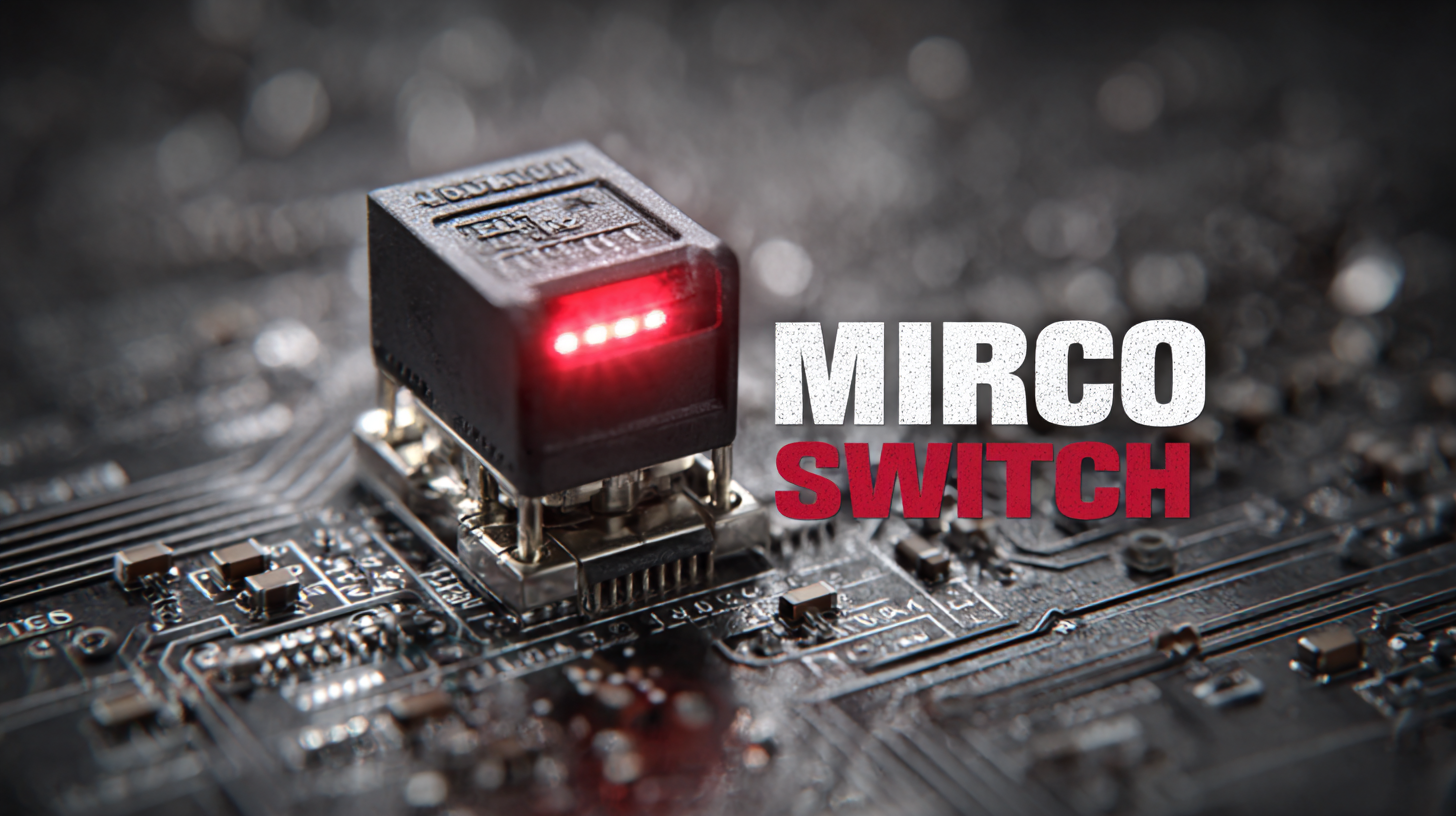Setting the Benchmark for Best Micro Switch On Off with Industry Standards
In today's rapidly evolving industrial landscape, the significance of high-quality components cannot be overstated, particularly when it comes to Micro Switch On Off devices. According to a recent report by MarketsandMarkets, the global micro switch market is projected to reach $2.6 billion by 2026, growing at a CAGR of 4.3% from 2021. This surge is driven by the rising demand across various sectors, including automotive, appliances, and industrial automation, where reliability and precision are paramount. Setting a benchmark for Micro Switch On Off solutions involves adhering to stringent industry standards that ensure optimal performance and longevity. As manufacturers grapple with quality control and compliance, understanding how to select and implement these switches effectively is crucial. This blog will delve into the best practices and industry standards that define superior Micro Switch On Off products, equipping readers with the knowledge to make informed decisions in their applications.

Understanding Micro Switches: Key Features and Functionality Explained
 Micro switches are a pivotal component in a wide array of devices, ensuring reliability and precision in electrical applications. Defined by their unique actuators and rapid switching capabilities, these switches operate on a simple principle: the physical movement of a lever or button triggers a mechanical action, resulting in fast and efficient on-off control. According to a market report by Research and Markets, the global micro switch market is expected to reach $3.1 billion by 2025, growing at a CAGR of 6.7%, highlighting their increasing importance in the automation industry.
Micro switches are a pivotal component in a wide array of devices, ensuring reliability and precision in electrical applications. Defined by their unique actuators and rapid switching capabilities, these switches operate on a simple principle: the physical movement of a lever or button triggers a mechanical action, resulting in fast and efficient on-off control. According to a market report by Research and Markets, the global micro switch market is expected to reach $3.1 billion by 2025, growing at a CAGR of 6.7%, highlighting their increasing importance in the automation industry.
One of the critical features of micro switches lies in their capacity for high precision and durability. Typically rated for over a million cycles, they are designed to withstand rigorous usage, making them ideal for applications ranging from home appliances to industrial equipment. The International Electrotechnical Commission (IEC) has established standards for micro switch performance, ensuring consistent quality and safety. Furthermore, modern designs incorporate various functionalities such as momentary and maintained actions, allowing manufacturers to cater to specific operational needs. This versatility underscores the vital role micro switches play in maintaining industry standards and enhancing operational efficiency in contemporary technology.
The Importance of Industry Standards for Micro Switch Performance and Safety
In today's highly competitive market, the performance and safety of micro switches have become paramount. Industry standards play a crucial role in ensuring that these components function reliably under various conditions. Compliance with established standards such as UL, IEC, and JIS not only helps manufacturers guarantee a consistent level of quality but also enhances the safety and efficacy of their products. By adhering to these benchmarks, companies can prevent potential failures that could lead to equipment malfunction or, worse, safety hazards.
Moreover, the importance of industry standards extends beyond mere compliance; it fosters trust among consumers and businesses alike. When a micro switch meets specific performance criteria, users can be confident in its longevity and reliability. These standards often include rigorous testing procedures that assess everything from electrical performance to mechanical durability. As such, they help create a culture of accountability within the industry, pushing manufacturers to prioritize innovation while ensuring that safety remains at the forefront of their design processes. Embracing these standards not only improves product quality but also solidifies a company's reputation in the marketplace.
Setting the Benchmark for Best Micro Switch On Off with Industry Standards
| Specification | Standard Value | Remarks |
|---|---|---|
| Operating Temperature Range | -40°C to 85°C | Suitable for extreme environments |
| Electrical Contacts Rating | 15A, 250VAC | Commonly used in household appliances |
| Mechanical Life | 10,000,000 operations | Ensures durability |
| IP Rating | IP67 | Dust-tight and protected against water immersion |
| Certification | UL, CE | Meets international safety standards |
Five Essential Criteria to Evaluate the Best Micro Switch Options
When evaluating the best micro switch options in the market, several essential criteria must be considered to ensure functionality and reliability. First and foremost, the switch's actuation force is crucial; it determines how much pressure is required to trigger the switch. A proper balance needs to be struck, as too high a force can result in user frustration, while too low may lead to unintended activations. Selecting the right actuation force plays a significant role in application suitability, whether for industrial machinery or consumer electronics.
Durability is another vital factor when assessing micro switches. The lifespan of a switch is often determined by its mechanical and electrical ratings, typically defined in terms of the number of cycles it can perform before failure. For environments with frequent use, considering switches that adhere to high durability standards, such as IP ratings for dust and moisture resistance, is essential. Additionally, evaluating the materials used in the switch construction can provide insights into its resilience against environmental stresses and temperature variations, ensuring consistent performance over time.
Comparing Operating Mechanisms: Lever vs. Roller vs. Plain Micro Switches
When it comes to micro switches, understanding the different operating mechanisms is crucial for making informed decisions in engineering applications. Among the three prevalent types—lever, roller, and plain micro switches—each offers unique advantages and operates under distinct principles. According to a 2020 report by the International Electrotechnical Commission (IEC), lever micro switches are known for their versatility and ability to handle higher actuation forces, making them ideal for applications requiring a robust solution. They excel in environments where space is limited, providing reliable performance with minimal physical footprint.
Roller micro switches, on the other hand, are designed to detect motion effectively. Their built-in rollers allow for the activation of the switch with lateral movement, which is particularly beneficial in conveyors and automated systems. A study published by the American Society of Mechanical Engineers (ASME) in 2021 highlighted that the use of roller micro switches can increase overall system efficiency by up to 15% in applications involving repetitive actions, thus minimizing wear and tear on mechanical components.
Plain micro switches are the go-to choice for cost-sensitive applications that do not require the additional features of their counterparts. While they may not offer the same level of versatility or efficiency, they are favored for their simplicity and reliability. The 2022 Electrical Components and Materials Report estimated that the demand for plain micro switches has surged by 25% over the past five years, showcasing their popularity in consumer electronics and home appliances. Understanding these distinctions can greatly impact the selection process in various engineering projects.

Top Brands of Micro Switches Setting Industry Benchmarks in Quality and Reliability
In the realm of electronic components, micro switches are vital for ensuring operational efficiency and reliability. Leading brands have consistently outperformed their competitors by adhering to strict industry standards, making significant contributions to the benchmarks of quality and performance. For instance, companies like Omron and Honeywell have established themselves as leaders by implementing innovative designs and rigorous testing processes that ensure their micro switches can withstand the test of time, even in the most demanding environments.
Durability and precision are crucial aspects that these top brands focus on. By utilizing advanced materials and engineering techniques, they produce micro switches that not only meet but exceed industry expectations. Features such as snap-action mechanisms and environmental resistance contribute to their longevity and functionality. As a result, manufacturers and engineers turn to these reputable brands when the need arises for reliable components that can guarantee performance across various applications, from automotive systems to home appliances. Their commitment to excellence continues to set the standard for micro switches in an ever-evolving marketplace.

